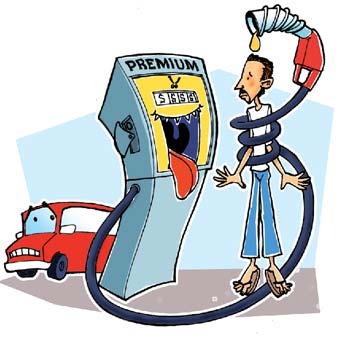How to Improve Your Fuel Economy and Save Money at the PumpWallet looking thin? Not getting the MPG you expect? Break out of the cycle and do yourself a favor by following these easy, fuel saving steps. Maintain Your Vehicle on a Regular BasisA poorly maintained vehicle will consume more fuel versus a vehicle that is serviced regularly. You can take your car to your local auto shop and have it checked up.
Check Your Tire Pressure Once a MonthKeeping your tires properly inflated according to vehicle specifications is essential to improving your fuel economy. Underinflated tires can put a huge dent on your MPG, reducing fuel economy by as much as 25%. Underinflated tires will not only reduce your miles to the gallon, but will also affect your vehicle's road handling and comfort. Not to mention, driving on tires with low pressure is dangerous for you, your passengers, and other drivers on the road. If the TPMS symbol  appears on your dashboard, don't ignore it. It means that one or more of your tires is 25 percent or more below the appropriate tire pressure appears on your dashboard, don't ignore it. It means that one or more of your tires is 25 percent or more below the appropriate tire pressureChange your Commute Time or Alter Your RoutesIf you can, try to schedule your trips during times when traffic is lighter and more forgiving. The RPM fluctuations that result from the constant pressing and releasing of your gas pedal in stop-and-go traffic can greatly increase your cars fuel consumption. You could also do a little bit of research for clear and congested routes on Traffic.com before you hit the road. Avoid the grind and take control of your commute with real-time traffic information. Combine Multiple Trips Into OneIf you've got a bunch of errands to run, try to handle each one in the same trip. Doing one thing, heading home, and repeating the process will put a hamper on your MPG. Free Up Weight and Reduce DragIf possible, try not to haul things in your trunk or store things in empty seats. For every extra 250 pounds your engine hauls, the car loses about one mile per gallon in fuel economy. Your car works hard to accelerate and overcome air resistance. Lighten the load and try to remove anything that would cause drag. Make Sure Your Gas Cap is Tight and Properly Screwed OnA lot of vehicles notify you with a "click" if your gas cap is on tight and secure. 147 million gallons of fuel vaporize every year in the U.S due to improperly secured gas caps. Drive at a Steady and Moderate SpeedOne of the most effective methods to improve your fuel economy is to accelerate slowly and brake over a longer distance. According to FuelEconomy.gov, "As a rule of thumb, you can assume that each 5 mph you driver over 60 mph is like paying an additional $0.20 per gallon for gas." Stepping on the gas and pushing your car will reduce your fuel consumption and so will sudden starts and stops. Try to Drive LessIf your destination is close, try to walk, ride your bike, take public transportation, or carpool. Walking and riding your bike is an excellent way to stay in shape and reduce our impact on the environment. Don't take your legs for granted! Also, support our nation's public transportation system and reduce your stress, avoid traffic, and save money at the pump.
|
